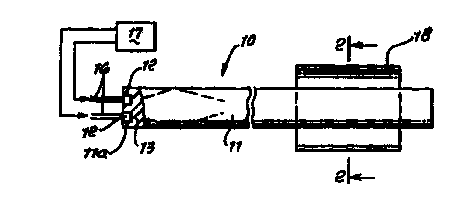Some of the information on this Web page has been provided by external sources. The Government of Canada is not responsible for the accuracy, reliability or currency of the information supplied by external sources. Users wishing to rely upon this information should consult directly with the source of the information. Content provided by external sources is not subject to official languages, privacy and accessibility requirements.
Any discrepancies in the text and image of the Claims and Abstract are due to differing posting times. Text of the Claims and Abstract are posted:
| (12) Patent Application: | (11) CA 2301573 |
|---|---|
| (54) English Title: | HIGH EFFICIENCY DIRECT COUPLING OF RADIANT ELECTROMAGNETIC ENERGY INTO DIELECTRIC WAVE GUIDE STRUCTURE |
| (54) French Title: | COUPLAGE DIRECT DE HAUTE EFFICACITE D'ENERGIE DIELECTRIQUE DANS UNE STRUCTURE DE GUIDE D'ONDE DIELECTRIQUE |
| Status: | Deemed Abandoned and Beyond the Period of Reinstatement - Pending Response to Notice of Disregarded Communication |
| (51) International Patent Classification (IPC): |
|
|---|---|
| (72) Inventors : |
|
| (73) Owners : |
|
| (71) Applicants : |
|
| (74) Agent: | SMART & BIGGAR LP |
| (74) Associate agent: | |
| (45) Issued: | |
| (86) PCT Filing Date: | 1997-09-18 |
| (87) Open to Public Inspection: | 1999-03-25 |
| Examination requested: | 2002-07-19 |
| Availability of licence: | N/A |
| Dedicated to the Public: | N/A |
| (25) Language of filing: | English |
| Patent Cooperation Treaty (PCT): | Yes |
|---|---|
| (86) PCT Filing Number: | PCT/US1997/016766 |
| (87) International Publication Number: | WO 1999014621 |
| (85) National Entry: | 2000-02-21 |
| (30) Application Priority Data: | None |
|---|
A radiant electromagnetic energy transmitting apparatus (10) comprises an
elongated rod (11) consisting of electromagnetic energy transmitting material
and a source of energy (12) having an end portion received into a recess (13)
in an end portion (11a) of the rod to transmit the energy in different
directions therein for effecting energy travel lengthwise along the rod.
L'invention porte sur un appareil (10) de transmission d'énergie électromagnétique rayonnante comprenant une tige allongée (11) constituée d'un matériau transmetteur d'énergie électromagnétique, et une source d'énergie (12) dont la partie terminale est reçue dans un évidement (13) d'une partie terminale (11a) de la tige de sorte que l'énergie soit transmise dans différentes directions et qu'elle se déplace le long de la tige.
Note: Claims are shown in the official language in which they were submitted.
Note: Descriptions are shown in the official language in which they were submitted.

2024-08-01:As part of the Next Generation Patents (NGP) transition, the Canadian Patents Database (CPD) now contains a more detailed Event History, which replicates the Event Log of our new back-office solution.
Please note that "Inactive:" events refers to events no longer in use in our new back-office solution.
For a clearer understanding of the status of the application/patent presented on this page, the site Disclaimer , as well as the definitions for Patent , Event History , Maintenance Fee and Payment History should be consulted.
| Description | Date |
|---|---|
| Time Limit for Reversal Expired | 2006-09-18 |
| Application Not Reinstated by Deadline | 2006-09-18 |
| Inactive: IPC from MCD | 2006-03-12 |
| Inactive: Abandoned - No reply to s.30(2) Rules requisition | 2006-02-16 |
| Deemed Abandoned - Failure to Respond to Maintenance Fee Notice | 2005-09-19 |
| Inactive: S.30(2) Rules - Examiner requisition | 2005-08-16 |
| Letter Sent | 2002-08-28 |
| Request for Examination Received | 2002-07-19 |
| All Requirements for Examination Determined Compliant | 2002-07-19 |
| Request for Examination Requirements Determined Compliant | 2002-07-19 |
| Letter Sent | 2001-05-23 |
| Letter Sent | 2001-05-23 |
| Inactive: Single transfer | 2001-04-19 |
| Inactive: Cover page published | 2000-05-02 |
| Inactive: IPC assigned | 2000-05-01 |
| Inactive: First IPC assigned | 2000-05-01 |
| Inactive: Courtesy letter - Evidence | 2000-04-18 |
| Inactive: Notice - National entry - No RFE | 2000-04-12 |
| Application Received - PCT | 2000-04-07 |
| Application Published (Open to Public Inspection) | 1999-03-25 |
| Abandonment Date | Reason | Reinstatement Date |
|---|---|---|
| 2005-09-19 |
The last payment was received on 2004-08-31
Note : If the full payment has not been received on or before the date indicated, a further fee may be required which may be one of the following
Please refer to the CIPO Patent Fees web page to see all current fee amounts.
| Fee Type | Anniversary Year | Due Date | Paid Date |
|---|---|---|---|
| MF (application, 2nd anniv.) - standard | 02 | 1999-09-20 | 2000-02-21 |
| Basic national fee - standard | 2000-02-21 | ||
| MF (application, 3rd anniv.) - standard | 03 | 2000-09-18 | 2000-06-23 |
| Registration of a document | 2001-04-19 | ||
| MF (application, 4th anniv.) - standard | 04 | 2001-09-18 | 2001-09-14 |
| Request for examination - standard | 2002-07-19 | ||
| MF (application, 5th anniv.) - standard | 05 | 2002-09-18 | 2002-08-19 |
| MF (application, 6th anniv.) - standard | 06 | 2003-09-18 | 2003-09-05 |
| MF (application, 7th anniv.) - standard | 07 | 2004-09-20 | 2004-08-31 |
Note: Records showing the ownership history in alphabetical order.
| Current Owners on Record |
|---|
| TELEDYNE LIGHTING AND DISPLAY PRODUCTS, INC. |
| Past Owners on Record |
|---|
| JOHN M. POPOVICH |